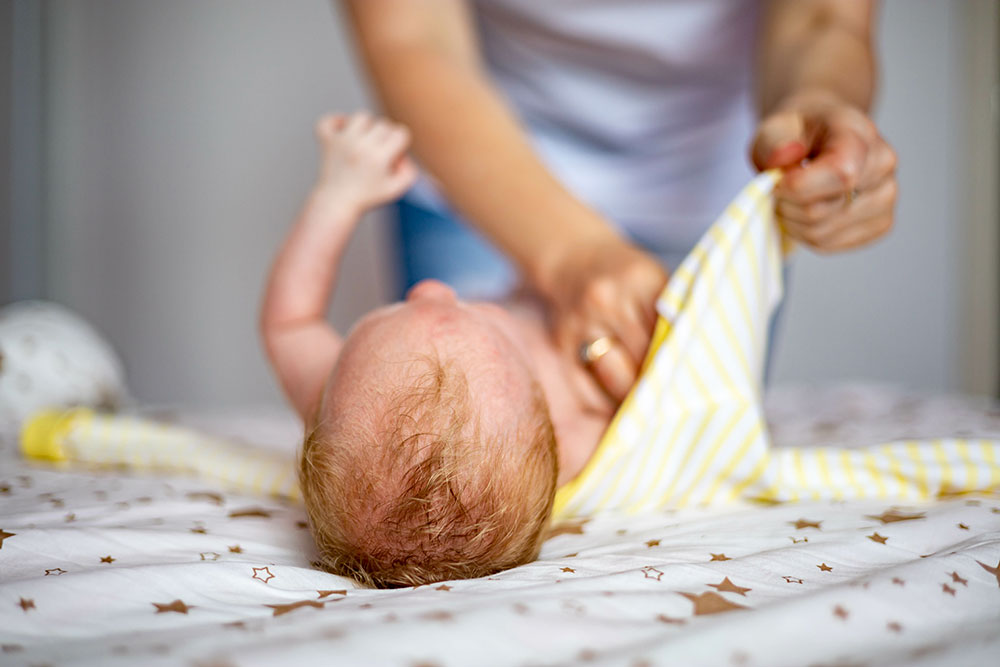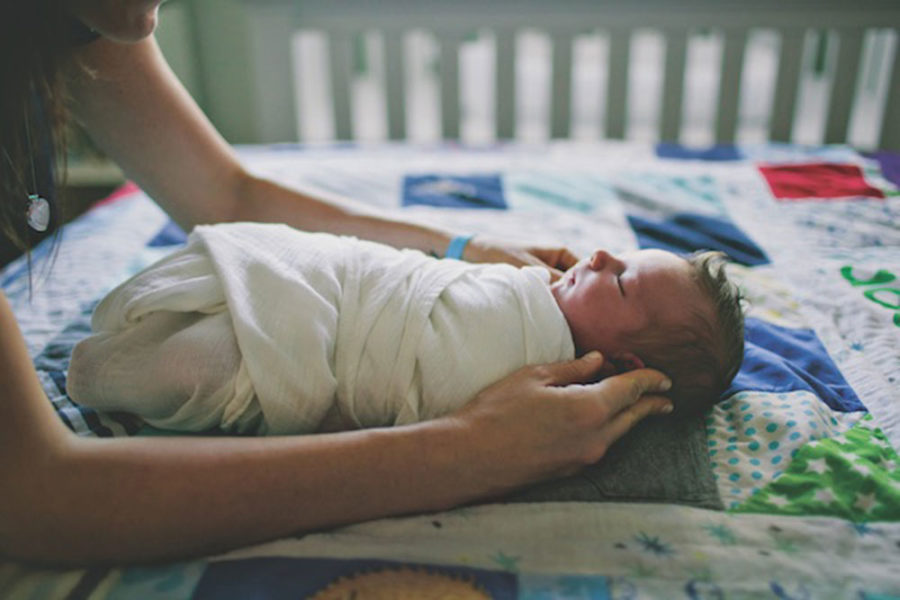That’s a Wrap: Best Practices for Safely Swaddling Your Newborn Baby

When done properly, swaddling can be an effective way for new parents to calm a restless infant and help everyone clock some shuteye.
Medical Experts: Amanda Lea, RN; Rachel Moon, MD; Jennifer Sonney, PhD
As timeless as a lullaby and nearly as soothing as being rocked in Mama’s arms, swaddling baby’s body has been recommended across generations and cultures as a trusted way to settle fussy babes. But although swaddling may be time-tested, it isn’t without risk. Wrap too tightly, and your baby can overheat. Wrap too loosely, and that cozy blanket can become a strangulation hazard. Wrap too long, and your older infant might roll over without any way to lift his head.
“Swaddling is definitely something you can do to help calm a fussy baby,” says Amanda Lea, RN, a pediatric nurse who has worked for the Monroe Carell Jr. Children’s Hospital at Vanderbilt University Medical Center in Nashville, Tennessee. “I completely understand how it feels when you put your baby down for a nap, and the dog barks or the mailman knocks on the door. As a parent, you don’t want your baby to be woken up. The downside of swaddling is that it decreases the startle reflex and spontaneous awakening, which can be dangerous. There is definitely a balance.”
Why Swaddle?
Studies have shown that a swaddled baby tends to sleep for longer stretches and wakes less easily than infants who aren’t. “There are some theories that swaddling mimics the tightly packed environment of the womb,” notes Jennifer Sonney, PhD, member of the National Association of Pediatric Nurse Practitioners and assistant professor at the University of Washington School of Nursing in Seattle.
But what’s more likely, according to Sonney, is that swaddling dulls a newborn’s startle, or more, reflex. That’s the hardwired reflex most present in the earlier months of age that causes your little one to fling their arms up and grasp at the air (often waking up in the process). You’ll notice this happens when there’s a sudden change in sensation such as a loud noise, a bright light, or even just a change in position.
By restricting arm movement, a swaddle blanket helps prevent baby from startling themselves awake. “Swaddling is helpful,” Lea advises. “But you have to be careful how and when you do it.”
The Basics of Bundling
Infants, especially preemies, aren’t always able to regulate their body temperature effectively—after all, they’ve spent the past nine or so months in a temperature-controlled environment. This makes your little one especially sensitive to overheating when you use a swaddling blanket, Lea says. If your newborn’s cheeks seem flushed, or if they’re starting to sweat, you’re probably bundling too snugly, or with a blanket that’s too bulky.
Tight swaddling can also make it difficult for baby to breathe, Sonney notes. “Make sure the wrap is secure, but not so tight that it restricts the ability for baby’s chest to properly expand.”
On the other hand, loose swaddling, like loose blankets, can become a strangulation or suffocation risk if your little one gets tangled up in it.
“You don’t want the top of the blanket to slip over the shoulders closer to baby’s head and cover the mouth or nose,” explains Sonney. “They can begin breathing in their own carbon dioxide.”
As a rule of thumb, keep the top of the blanket level with your newborn’s shoulders when you swaddle, and make sure you can slide two of your fingers between the swaddling and your little one’s chest. For a step-by-step guide, refer to Pregnancy & Newborn’s cheat sheet.
Reduce Rollover Risk
Pediatricians recommend that parents stop swaddling their newbies at about the 2-month mark. Many babies begin rolling over, or at least attempting to, when they’re around 2 months old—and they often do it when you’re not looking. Even the most attentive parents can be surprised to find out their wee one has mastered this milestone.
“The babies who get into trouble are the ones who are on their stomachs,” notes Rachel Moon, MD, a pediatrician at the University of Virginia School of Medicine in Charlottesville, Virginia. As chair of the American Academy of Pediatrics’ (AAP) Task Force on Sudden Infant Death Syndrome (SIDS), Moon also led a recent study that examined potential connections between swaddling and the risk of SIDS and infant death.
All babies should be placed on a flat surface on their backs to sleep, according to AAP recommendations. Still, a 2- or 3-month-old infant can roll onto their stomach overnight or during naptime. “If they’re swaddled, they have no defense mechanism,” Moon says. “It’s a very hazardous situation.”
As you transition away from swaddling, Sonney suggests taking the opportunity to firm up your baby’s sleep routine and begin building good sleep habits. Gradually wind down activities, reduce stimulation, and dim lights as the evening progresses. Then, after a bath, feeding, and a cuddle, put your baby down in his crib at a predictable hour each night. “Sleep is very habit-based,” Sonney explains. “If you follow the same routine every night, the body will come to expect sleep.”
You can also look into sleep sacks or wearable blankets at night if you’re worried about keeping baby warm and maintaining safe sleep. The added weight of the garments may ease the transition out of swaddling for some babies.
Moon also hopes to change the conversation on infant sleep in general. We often think of a “good sleeper” as a baby who sleeps through the night. But for newborns, that’s not a realistic expectation.
“A 2-month-old baby is not going to sleep seven hours straight,” she says. “They’re designed to wake up every few hours. This is normal, and it’s a phase that won’t last forever.”
To Moon, a good sleeper is one who wakes up in the night to feed, then falls easily back to sleep afterward. Lea agrees. “If you have a baby who’s sleeping for three- or four-hour stretches, I think you’re definitely winning,” she says. “You have a good sleeper.”








